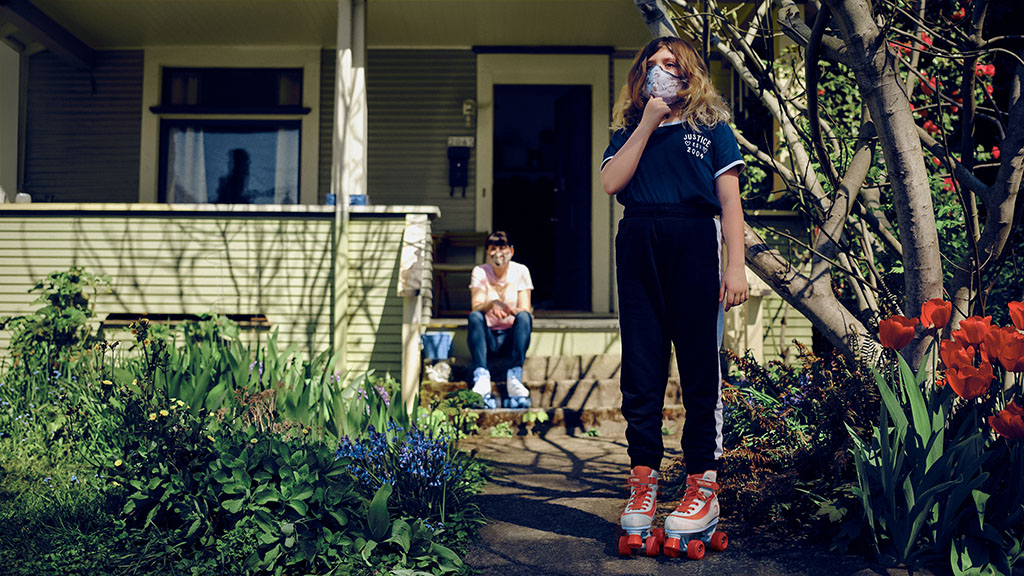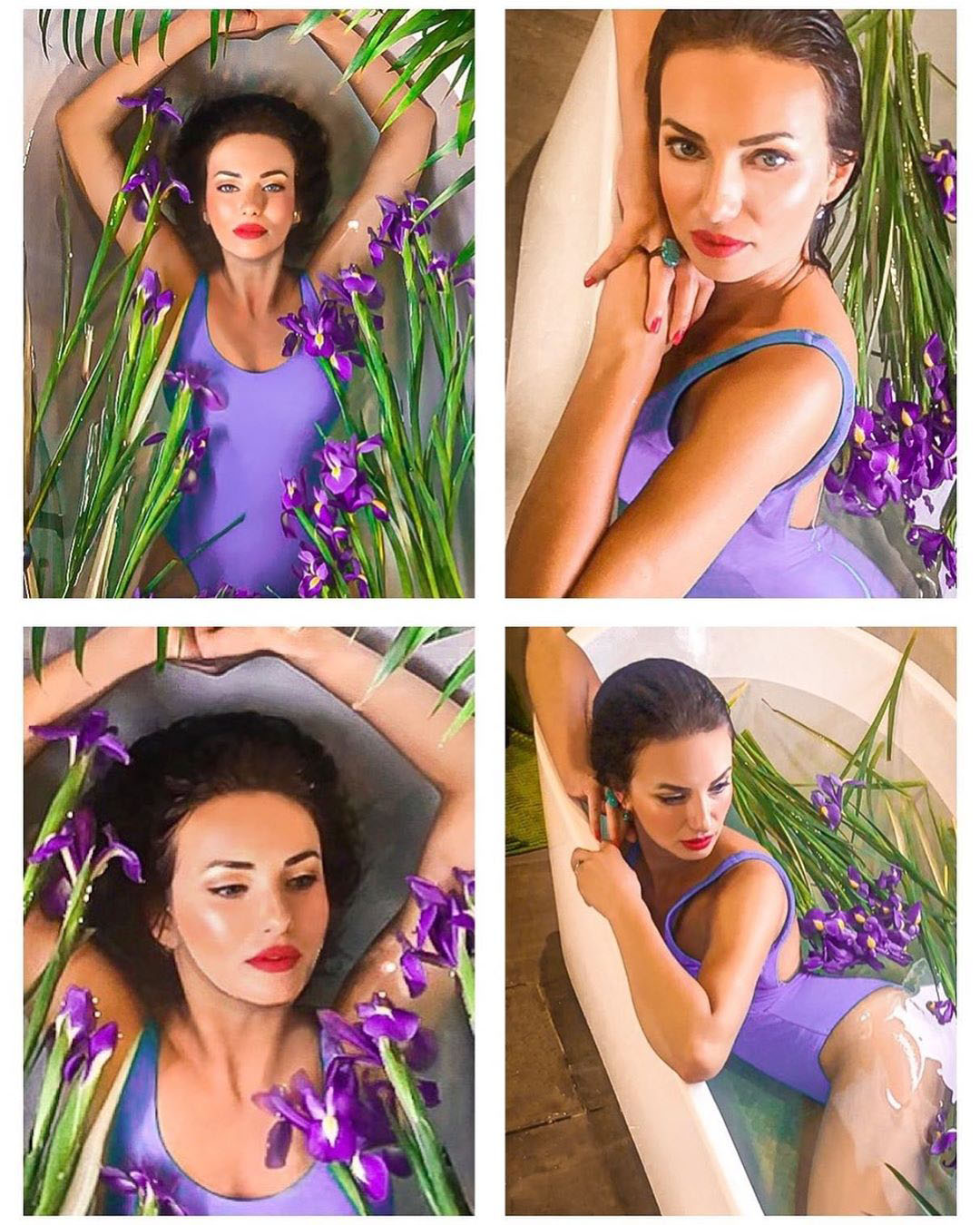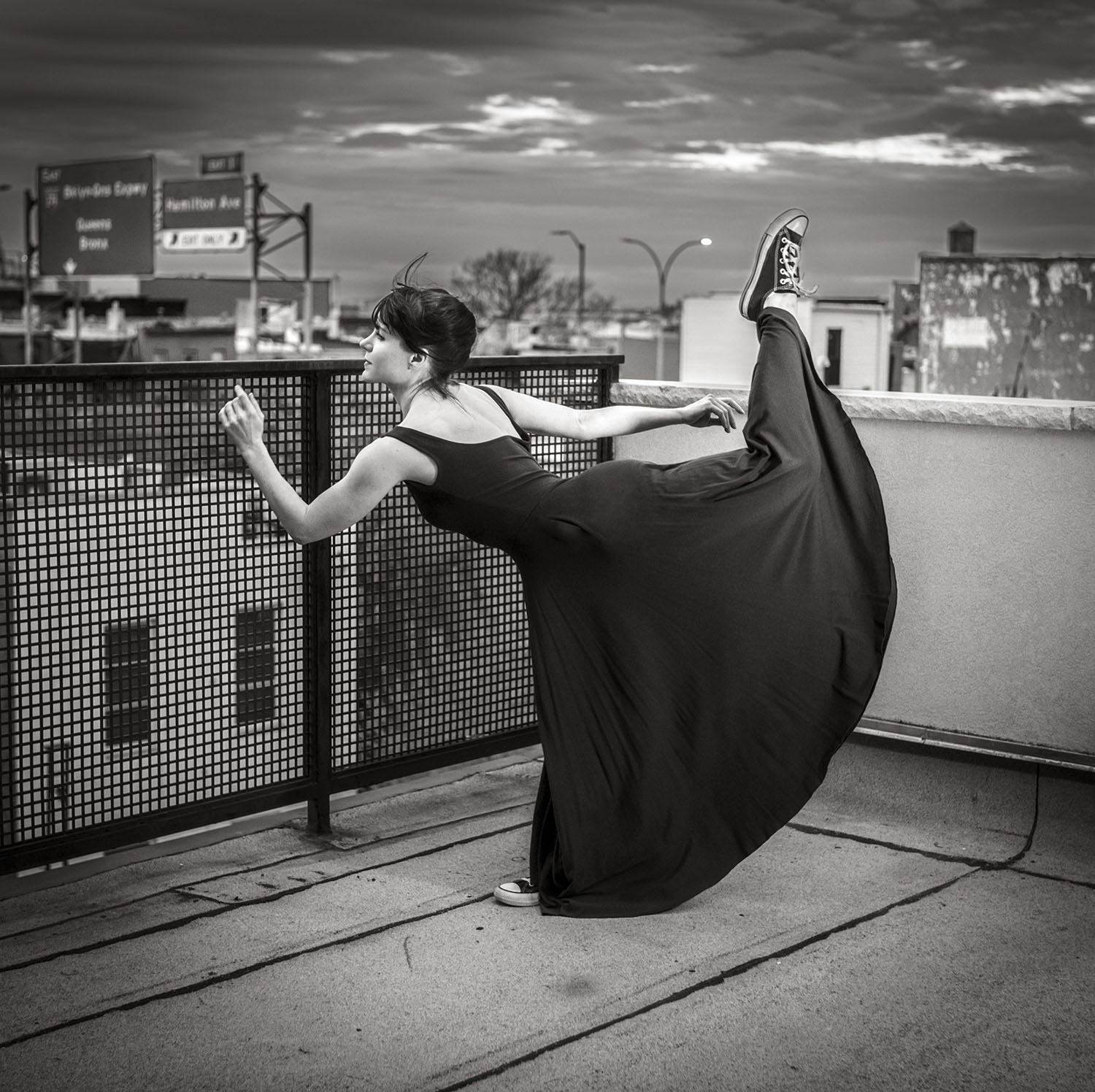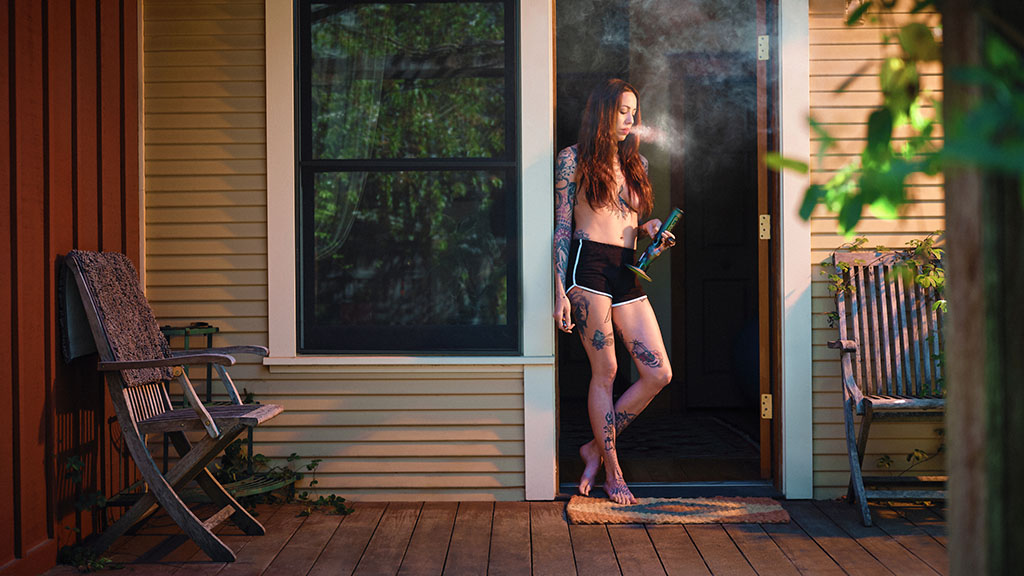How Photographers Are Turning Limitations Into Fascinating Reflections On Our Times
In early May, Brooklyn-based photographer Monique Carboni rode a rented bike across Brooklyn adorned with clamp lamps, camera equipment, and a tripod. A far cry from the production photography Carboni was doing earlier this year on and off-Broadway, she was deep into her Quaranportrait series, on her way to shoot dancer Eran Bugge on a Park Slope rooftop. Documenting New Yorkers in isolation, most of the series’ photos were taken through a window at dusk, illuminating their version of the socially distanced world collectively entered into in March.
“I saw my friend John Carlin, who was the very first Quaranportrait, posting on his Instagram that he was recording songs in this apartment,” says Carboni. “All of a sudden, it clicked, with my production photography skills, that it might be cool for me to photograph him in his window while he’s recording,” says Carboni, who soon expanded the project to photograph others. On evenings she could walk to the subject’s house, it was often with a six-foot ladder and hand cart in tow, sometimes as far as 40 minutes each way, for further distances, the bike.
Though photography is an inherently intimate medium, with the coronavirus here to stay for a while, photographers, like Carboni, are working with the limitations presented to create fascinating reflections of the times. Take NashCO, a Portland-based photography company run by spouses Leah Nash and Christopher Onstott. They faced a sudden change in reality when their mid-March shoot got canceled the day before. Within the week, their next three to four months of work had also been postponed or canceled. “In the beginning, it was quite tense, I was experiencing a lot of anxiety,” says Nash. “We’re used to being quite busy, photographing a lot, and so, suddenly, to have that all end we were like, okay, well we need to do something—I mean we’re still photographers, we still want to be photographing.”

Slowly the idea for a project, later entitled Shelter In Place, began to take form. “Both of our backgrounds are photojournalism, so, for us, it was really important to record and document this moment—have a record of it visually,” says Nash of the series documenting how people in Portland were spending lockdown.
Nash and Onsott both took a turn in front of the lens before turning it on anyone else. “The first time we did it, we weren’t quite sure how it was supposed to look or what it was supposed to feel like,” says Onsott. “It took us a little while to work through it, emotionally, visually, and to get a handle on how we were feeling about everything and what the pictures look like. It was different than what we normally shoot.”
They reached out to friends and family to participate before extending their search to Craigslist and Facebook. “Everyone was in their own microbubble, not seeing people. The idea was to discover how other people were experiencing dealing with, handling, being sheltered in place,” says Onsott.
The pair also hoped to bond with others. “That’s a big reason that Christopher and I both do this, is to connect with people, so that was a big part of it too,” says Nash. “It was just a great way to feel like, okay, we’re being a part of our community, we’re interacting with people, and people responded really well.”
Of course, things were a bit different. “As a photographer, you’re always doing like ten different things. Like I’m trying to make an emotional connection with you. I’ve got all this technical stuff I’m doing and I’m also trying to be creative. Now I’m also trying to be very safe. Am I covering my face? Is my mask working right? Have I sanitized my hands? Did I touch something? It adds a whole other layer of things to think about when we’re already thinking about a lot,” says Onsott.
Even with these necessary barriers, the strength of human connection persisted. “One of the women we photographed, she was a brand new single mother, she was going to school, and then school got canceled, and we photographed her on Mother’s Day. She was going through post-partum depression she was saying, and so it was quite an emotional thing for her,” says Nash. “At the end of it, she was like thank you so much I really feel validated.”
As the creative behind Photopia in Washington D.C., Elizabeth Dranitzke also understands the importance of connecting with people, even in a socially distanced world. Working as a portrait photographer for 18 years, Dranitzke repeatedly works with many of her subjects, recently doing a senior portrait session for someone she had photographed as a baby. “I have always valued these long-term relationships with clients, and I feel like that has given so much meaning to my work,” she says.
Shortly after quarantine began, the mom of a neighborhood kid Dranitzke had shot at three years old asked if she would do a socially distanced photoshoot for the same son’s high school graduation. She accepted. “I realized I often photograph from at least six feet apart, and I use a zoom lens,” she says. “But, as a small business, my work just bottomed out—I mean, that was what was really terrifying. It got quiet fast.”

Dranitzke stumbled upon a woman online doing front porch portraits for free. After hearing about a local nonprofit helping those impacted by the coronavirus, she decided to shoot some herself in exchange for subjects donating money to the organization. “I said, if you can only give $5, I don’t care. Some people gave $100, a lot of people gave $50. One neighbor gave $500. So I raised over $3000, which felt great,” she recalls.
With no income coming in, and the support of her women’s business group, Dranitzke began charging for the portraits, giving clients the option to donate a portion of the proceeds. She quickly saw the comradery existing around small business owners to support each other. “I did a job recently that was a front porch family mini session. She had been in touch for a while, but she’s a freelancer and didn’t have income. But she got a contract and she texted me last week and said, woohoo, I got a contract—I got money. Let’s do it. And so it’s really that ripple effect that we all are very aware of,” says Dranitzke, though she has found some people, on the other hand, hesitant to be photographed without easy access to a salon. “Some people say like, I was going to do my headshot, but I really wanted professional makeup, and I can’t get my hair cut or my roots touched up or whatever.”
Another problem some photographers have faced: an inability to do face-to-face photoshoots altogether—something FaceTime has helped remedy. Due to restrictions in the United Kingdom, Scottish photographer Paul Francis was unable to do in-person shoots until the last week of June. He spent four to five weeks creating mood boards for future projects, feeling increasingly frustrated as time went on and he was unable to pursue that creative avenue. “Then I came across a shoot that someone else had done and it said it had been shot via FaceTime. I thought, wow, that’s quite incredible,” says Francis, who enlisted a friend to help him try out the new medium. “The material that came from that just spun more work essentially.”
Francis isn’t doing photoshoots over FaceTime for pay, though some professionals are, but he hopes it maintains his credibility and profile during this period. Thanks to the networking it provides and unique style of work, he plans to continue even once traditional photography is more accessible. His only concern is models being taken advantage of over FaceTime and stresses that everyone does their due diligence on who they’re working with.

Though all executed in distinct ways, each of these photographers have found a way to use their talent to capture this unique period in history and, despite everything, create something beautiful.
“In some ways, it was a gift because we are normally too busy to do personal work. We always want to, and so, in some way, it ended up being really positive for us because it gave us a chance to kind of reset,” says Nash. The Shelter in Place series ended when Portland’s lockdown order did. The couple is now pursuing another project geared towards uniting the country: this time to vote. “I wanted to do something about using your voice,” says Onsott. “Everyone seems quite polarised right now, and people seem sort of tense about the political situation across the country. So I was like, what if I just have people scream and let it all out?”
One person who has undoubtedly used their voice is Carboni. “I feel more vocal now because I was the lighting designer, the costume designer, the art director, and the director. They would have me on speakerphone inside, and I would have my phone in a little fanny pack tied around my neck, talking to them from the street directing the shoot,” she says. “This project gave me so much more confidence as an artist. I directed and did all of this on my own—I had no idea I had it in me, it was pretty amazing.”

Carboni took 19 Quaranportraits in total, an accidental nod to the virus which spurred the project in the first place. Soon after Black Lives Matter protests began and she pivoted to capturing another critical moment in history. “Nineteen was a friend of mine who I know from the theater who reached out and was like, we lost our apartment. He hadn’t gotten through to unemployment at that point. He had no money. So he had to leave his apartment of 15 years, and he was like I would love for you to come photograph me,” says Carboni. “I climbed up his fire escape and shot him and his girlfriend the night before they were leaving. It was a Friday night, and Saturday morning that was it, they were gone — packing up 15 years of being in that apartment because of the pandemic.”
Though she profiled celebrities like actor Ethan Hawke and playwright Lynn Nottage, Carboni acknowledges the importance of that last, frank shoot. “Before him, it was such fancy people and apartments or fancy dancers on the roof, and then his was the real story of COVID-19—that’s the truth of what’s happening,” she says. “These other people are great, and I love shooting them, but they’re well off and have nice apartments. They’re not worried about not working for the next six months, but most people are.”

